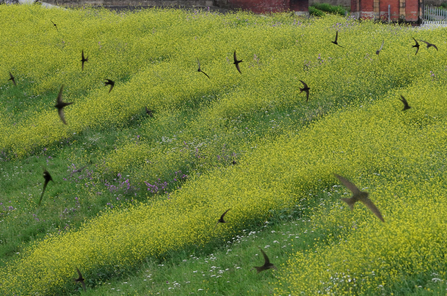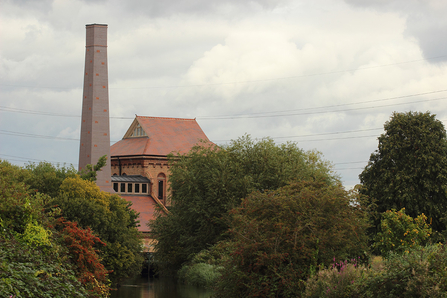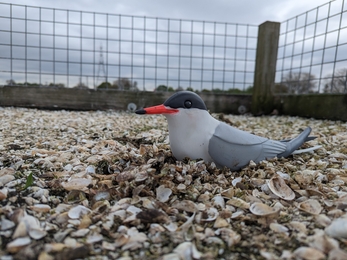Based at Walthamstow Wetlands, a reservoir complex within the lower Lee Valley, I joined the London Wildlife Trust in this role in 2021. To help explain some of the tasks I do, I will focus on two species that visit the UK during summer to breed. They also happen to be two of my favourite birds, the common tern and swift.
Both birds are widely distributed across the world, travel staggering distances during migration and can adapt to new breeding opportunities. Despite these similarities, they live very different and separate lives. Terns are reliant on water, commonly seen fishing along stretches of coast or inland on reservoirs and lakes, and breed on shingle beaches, coves, and islands. While the swift is reliant on the sky, almost entirely cutting ties with the land to feed, drink, mate, and sleep on the wing, only landing to nest. However, they both face the growing challenge of fitting in our very busy cities and coasts.
What do I do to help?
Common terns have nested at Walthamstow Reservoirs (and the wider Lee Valley) for several decades due to the provision of human made floating rafts. The use of rafts and artificial structures to create tern nesting habitat is a long-established and widely used management technique. At its peak, 44 pairs nested at the Reservoirs in the early 2000s but the population slowly declined as the rafts deteriorated. This resulted in just a single nesting pair in 2018.
To recover our breeding population, Thames Water created and installed several new rafts on one of the Reservoirs in 2019. With the help of our dedicated London Wildlife Trust volunteers, it is my role to monitor these. This consists of regular counts from the reservoir bank to keep tabs on the number of pairs, time of hatching and so on. This has been made a whole lot easier with the generous donation of binoculars from Leica!

Common tern feeding chick
Photo credit: Ann Playford
To ensure the rafts were irresistible, I made and placed tern decoys on the rafts (a common method to encourage terns to nest) in the hope they would catch the eye of any passing terns and thankfully it worked! Since 2021, we have had 13 – 20 breeding pairs each year which is super exciting.
As part of monitoring, we visit the rafts to tag the chicks to better understand their movements, longevity, and mortality1. For example, one of our ringed chicks were resighted on a salt pan in southern Spain! It has been a real success, building the colony from the single pair in 2018 to what is now a healthy population providing great data.
That isn’t to say it is now plain sailing; the arrival of black-headed gulls could provide competition for nesting spaces (as observed elsewhere in the Lee Valley), the looming threat of Avian Flu and sometimes the birds just don’t do what you want/predict them to do. As I write this, the population is giving me the run around and have chosen not to nest on the bespoke rafts built for them and are nesting elsewhere on site, which makes monitoring very tricky!
As for swifts, for starters, they are the best bird in the world. As someone who lives in the city, they are our wonderful reminder of summer migration and are a flagship species for urban conservation.
Swifts feeding at Walthamstow Wetlands has to be one of the top urban nature experiences out there.
During cloudy, windy and slightly chilly days, swifts are driven to feed at a very midgey Walthamstow as feeding opportunities for flying insects are unfavourable elsewhere. In search of food, they often arrive in their hundreds and can sometimes reach one, possibly two, thousand individuals all feeding low over the water as insects emerge from the reservoirs. Swooping, swirling and screaming, you can almost reach out and touch them at times. I'm not kidding, check out this swift hurricane.
However, we can help by putting up swift boxes on our homes to recreate nesting sites. These small-scale efforts can make a big difference, especially through community involvement and the great work local swift groups do.

Common swifts feeding at Walthamstow Wetlands
Photo credit: Ann Playford
The free-fall decline of insects is one of the key pressures that is driving swift decline, but another is the loss of nesting sites. Swifts nesting in human structures goes way further back in history than terns and rafts. They use to nest in ancient forests, and some still do, (there’s a small population in Abernethy Forest) but due to habitat loss the overwhelming number of swifts now nest in the cracks of our walls and the eaves of our houses. This has likely occurred since the Roman period, demonstrating the amazing adaptability of birds. Unfortunately, we have a habit of shutting nature out and modern housing and renovations to older homes stamp out any space for swifts. However, we can recreate nesting sites by putting up swift boxes on our homes, and these small-scale efforts can make a big difference, especially through community involvement and the great work done by local swift groups.
At Walthamstow Wetlands, a swift tower was constructed to replace the old chimney that was pulled down after the Ferry Pumping Station switched from steam to electric. As well as being a nod to the building’s industrial past, this tower has potential to host 36 breeding swift pairs. Despite swifts being in decline and us playing their favourite soundtrack of the summer (their own voices/screeches on repeat) to attract them, they are yet to use it!

The swift tower at Walthamstow Wetlands
Photo credit: Ian Phillips
As I mentioned previously, birds do not always do what you hope/predict they will do. The specific challenge with swifts is that they return to the same spot each year to nest. Which is remarkable given the monogamous couple part ways after breeding and re-find each other 9 months later after separately chasing the rains across Sub-Saharan Africa. Perseverance with playing the calls each summer is needed; you don’t just put up a tower and forget about it.
However, a few species have taken a liking to the tower, parakeets chew at it for its salts and minerals, and it has been occupied by a few pairs of nesting great and blue tits, so an expensive tit tower! Thankfully, last year, several pairs of house sparrows nested in the tower, it’s nice to see a red listed bird that is in trouble benefitting from it. Encouragingly, I have read that where house sparrows go, swifts soon follow…it must be the chirping. Here’s hoping they nest in the tower during my watch.
If you would like to support the London Wildlife Trust in protecting and conserving wildlife in the city, please consider either donating or becoming a member here
1 In collaboration with the Southern Colour Ringing Group, a group that studies various species using colour marking in London, Essex and Hertfordshire.

Thank you to Leica Sports Optics for supporting our activities at Walthamstow Wetlands
Instagram: leicanature
Facebook: Leica.Sport.Optics
Twitter: LeicaBirding






